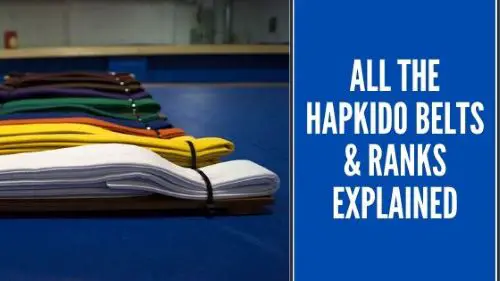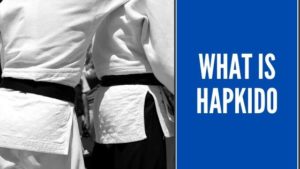Over the years, Hapkido has become very popular around the world. The Korean originated art, derives its fame from the fact that you are able to avoid the use of strength against strength. The birth of modern hapkido traces its roots from a group of Korean subjects in the post Japanese expatriate era.
In any training, monitoring your progress is key. Hapkido, just like other martial arts, allows a student to test and grade themselves while leading them through a run of different belt rankings and levels.
Traditionally, there are five basic colors in the hapkido belt system that symbolizes your growth as a student. In the West, however, the idea of these belt colors became hard to implement leading to the introduction of different ranking colors in Hapkido schools.
Hapkido Belt Ranking
Generally there are two belts in hapkido, the white and black belt. Rank distinction was utilized during the late 1970s and early 1980s as a result of testing values by South Korean built Taekwondo organizations.
Most hapkido organizations have six belt levels that guide a student through ranking.
- 1st Level: At this stage, a student learns the basics of Hapkido. This is a white belt level where the student is introduced to basic techniques such as punch and chop, defending against parallel and front wrist grabbing using one hand.
- 2nd Level: After advancing from the white belt, a student successfully joins the yellow belt level. At this point, you are able to learn techniques like defense against diagonals, lobs and the 25 basic kicks.
- 3rd Level: This is a two yellow belt level. In this martial art form, a student is able to learn defense against the front clothes while clutching with one hand.
- 4th Level: The highest point of this rank is being able to learn defense against being grabbed at the back. This is a blue belt level.
- 5th Level: This is also a blue belt level where a student is taught to defend against punches. It is important to note that this level is importantly crucial.
- 6th Level: This is a fairly advanced level where a student attains a red belt after attaining techniques in defense against choking, defense against armed attack and defense against choking. This level has four to five levels of red belts.
The following is a standard combat hapkido promotion rank based on grade, commonly referred to as the Gup and the Dan, in other words, the degree.
It is important to note that while the belt color represents different ranks, the colors are also a symbol of different “mantras.” With each level, comes a different concept taught to a student.
Related: What is Hapkido the Martial Arts
10th Gup White Belt
This is the beginner level that takes two months of 36 hours where a student attends a three and a half hour class at least three days every week. This level uses the circular motion hapkido concept with the following techniques taught. For stunts, a student is taught the following methods, resting, defense, horse riding, offensive and attention.
In strikes, the following techniques are taught, jab, hook, cross and uppercut while kicks like front and round horse are also introduced to the student.
The first evasion concepts techniques used are middle or both hands inwards, upper or front hand and arm outward, and lastly the lower front arm outward.
For circular motion ideas, the following techniques are used, wrist grabbing and twist while pushing into your attacker with the elbow, grabbing your clothes above and below your aggressor’s hand, the 2 hand choke technique that involves raising 1 hand over your head while rotating to inside over your attacker’s arms.
9th Gup Yellow Belt
This novice level has yellow, green or orange belts that take 36 hours. At this level the following techniques are taught, basic kicks like knee and backs, striking using the dropping elbow, upward elbow, inward elbow and backward elbow methods. For strikes, a student learns jabs, hooks and crosses.
The following concepts are taught, arm bar over technique by same hand, cross hand, rear collar, single choke and push. Another technique taught here is hand attacks by, front lapel, push intercept, same hand, multiple grabs and push intercept. In falling, you learn the side L and R technique.
8th Gup Yellow Belt/ Orange Belt
This is another yellow, green or orange belt that takes 36 hours of training. The following is a description of the techniques taught on this level, front leg kicks and sidekicks, downward hammer, inward hammer, outward hammer and rising hammer strikes.
There are two concepts used here, the S-Lock and Arm bar under. This involves the same hand, elbow lock, front collar, front shoulder, shoulder lever, and side grab. For striking drills, a student is taught the uppercut, jabs and crosses. Another technique taught here is falling forward while moving into sides.
7th Gup Yellow Belt/ Green
Training on this level takes approximately 36 hours considering a student takes a three days class of one and a half hours. A student is taught the following techniques for the release, which involves two hands grabbing one wrist.
Another technique used is the hammerlock or the same side grab and the same side wrist grab. Finally, a student also learns the push defense which involves outside trapping of your attackers’ punching arm.
6th Gup Blue Belt
This is an intermediate level that takes 36 hours of practice. The training involves techniques like palm jab, back fist, downward back fist strikes, while for kicks a student learns the shin and turning back procedures. The jab, uppercut, hook and cross are the striking drills taught on this level.
Concepts applied here are V-lock and Balance stationary. The V-Lock involves learning front shoulder, cross hand, same hand, figure four and rear shoulder techniques while the balance stationary involves figure 4 throw, hip throw, sweep, shoulder throw and knee sweep techniques.
5th Gup Blue Belt
This level takes 54 hours of practice. The techniques trained here are the sliding front and leg front side kicks, rising elbow, elbow over, elbow jab and outward elbow strikes. Other techniques imparted on this level are falling back and front, cross and jab striking drills.
The concepts gained are, chokes, which involves techniques like Half Nelson, sleeper, guillotine, clothing across and arresting techniques, head control, arm bar over and arm bar under.
4th Gup Blue Belt/Brown
It takes 108 hours of practice for a student to earn this belt. Some of the notable techniques and skills acquired are, defense against 2 hands while grabbing both wrists from behind, defense against a 1 hand lapel grab and defense against 2 hands while grabbing both wrists from the front.
3rd Gup Red Belt
This is an advanced level that takes 108 contact hours. Skills earned on this level are, forearm strikes, spinning back fist, reverse palm heel and spinning elbow techniques. Striking drills learnt are jab, turning and cross while kicks techniques taught are the crescent and stepping side.
Concepts acquired on this level are balance motion, kick defense, inside and outside front snap kick.
2nd Gup Red Belt/ Red and Black Belt
It takes 108 hours because this is an advanced level. A leaner acquires the following skills, tiger mouth, rolling punch, outer forearm and rolling back fist strikes. For kicks and striking drills, the following techniques are acquired, jump turning kicks, low spinning hook kicks, front, cross and jab.
The concept acquired on this level is ground defense that involves the following techniques, hand attacks, leg attacks, V-locks, S-lock, balance break, standing movement and defensive position.
1st Gup Black and White Belt
This level will take a student 162 hours of practice. It involves techniques like weapon defense, knife backslash, knife thrust or stab, and bat inward/outward.
1st Dan Black Belt
This is a very advanced level that involves 2 years of practice. Some of the techniques acquired are 360 turning back kick, spinning heel, spinning hook and hook punch defense that ensure each defense is a takedown.
A learner acquires the following skills, principle A.B.C (Air, Balance, and Control) and principle B.M.T (Break, Make, and Take) which makes the concepts efficient.
Related: Hapkido vs Aikido: The Similarities & Differences
Hapkido is evidently popular across the globe as can be seen by its use in famous movies such as Demolition Man (1993), and Blade (1998). Whereas hapkido belt colors can be puzzling, its ranking system is widely supported by various Hapkido Organizations in the world.






